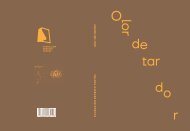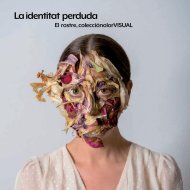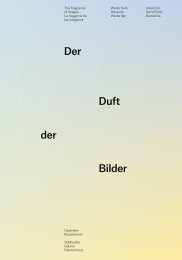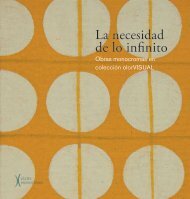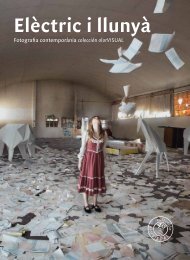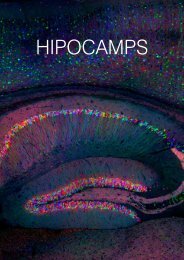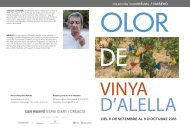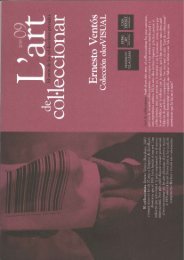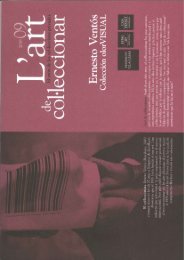You also want an ePaper? Increase the reach of your titles
YUMPU automatically turns print PDFs into web optimized ePapers that Google loves.
As the viewers, we are thus like a kind of imperfect librarian, as Borges says about<br />
man in his story The Library of Babel. All of this is not too far from the perfumer’s<br />
piano, that precious tool of the composer of fragrances, where the bottles that<br />
contain the different raw materials used to craft the essences are stored. Just like<br />
Ernesto Ventós, we know that life smells and penetrates us without barriers, imposing<br />
its presence. In the transmission of a memory, smells do not deteriorate as much<br />
as images do; instead, smells remain vivid, like a refuge for memory. As Walter<br />
Benjamin pointed out, “A scent may drown years in the odour it recalls”. This<br />
collection appeals to the need to interpret scent correctly, to go beyond its virtual<br />
immateriality to sensitise the immediate, like a musical performance. Eugenio Merino<br />
ironically represents it when he sculpts the collector kneeling with a reproduction of<br />
Manzoni’s Artist’s Shit, thus multiplying its impossibility and paradoxical nature. But<br />
beyond the conceptual play, scent has no limits, especially in this collection where the<br />
visual is interpreted and distilled through a kind of sense orgy.<br />
We can think about the theories of Michel Serres, for whom the history of<br />
science is subjected to turbulence; that is, it is subjected to random connections<br />
of all kinds among different areas. The viewer standing before the works in the<br />
olorVISUAL collection is also witnessing a kind of drift. Meantime, a series of<br />
quotes, texts mostly written by the authors of the works, give us hints as to what<br />
they aim to tell us, brief texts that reveal obsessions, sometimes more literal,<br />
other times more poetic, like a chaotic walk where experience reigns supreme.<br />
Perhaps because of all of this, there is no centre to the exhibition; all angles and<br />
directions are valid when deciding on the way to take through it. The exception is<br />
the starting point, where the figure of the collector holding Artist’s Shit accompanies<br />
premises like the one proposed by Joan Brossa, that perfume is the confetti of the<br />
nose, or that ideas can be smelled, as projected by the work by Eugenio Ampudia.<br />
Scent becomes like a solid, iron root, like the landscape sculpted by Martín<br />
Chirino, although paradoxically it becomes fluid, like the trace of magenta that is<br />
diluted like the scent of Tom Carr. As Juan Luis Moraza notes, the nose occupies<br />
the centre of the universe and the aura exists in the olfactory sense.<br />
I believe that it is easier for something to smell of the past than of the future.<br />
To Miroslaw Balka, the smell of the past is concealed in the scent of materials, of<br />
sculptures. Balka thinks about the scent of Christmas tree pine needles, or a bar of<br />
soap, or rubber. Scent as the trigger of memory is a dangerous knot. Like that which<br />
Jorge Perianes uses to engage an apple that does not smell with a tree growing out of<br />
the wall. It is an illusory reality yet also a synaesthetic one, since we can see it.<br />
Balka’s and Perianes’ materials are simple and everyday, but more than<br />
anything they are a resonance of memory. I believe that they somehow sketch<br />
an erotic connection with death, like in Bataille’s philosophy, a death that is<br />
paradoxically the scent of existence. It is as if progress ended up devouring<br />
us, heralding the end even before beginning. Not a few works smell of difficult<br />
times, like the harsh, elegant winter offered by Eva Lootz. The artist points out<br />
how copper does not smell, but the hand working with it does. In her work, snow<br />
is drawn like skin and the sky as frozen silence. This work, like the ones by Balka<br />
and Perianes, inspires in us a kind of nostalgia for nature. We can also notice it<br />
in the cigar and smokeless pipe by Chema Madoz. Or in Robert Mapplethorpe’s<br />
bare flower, surrounded by smoke, which holds up without wilting, like a<br />
youthful, apollonian, serene body. The sexual connotations are obvious, as<br />
they are in the bouquet of roses by Juan Hidalgo, which are accompanied by a<br />
mirror and a condom. But Tony Matelly’s work is clearly where the eternal takes<br />
on the most significance, falsifying weeds and stressing, in this case, the character<br />
of abandoned site that comes to mind when thinking about the revival of this<br />
space of La Tabacalera.<br />
133




